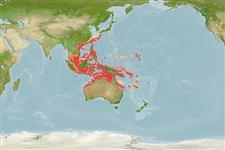>
Eupercaria/misc (Various families in series Eupercaria) >
Lutjanidae (Snappers) > Paradicichthyinae
Etymology: Symphorus: Greek, syn, symphysis = grown together + Greek, physis = growth body form + Greek, oura = tail (Ref. 45335).
More on author: Bleeker.
Environment: milieu / climate zone / depth range / distribution range
Écologie
marin récifal; profondeur 20 - 100 m (Ref. 57178). Tropical; 32°N - 26°S, 98°E - 170°E (Ref. 55)
Western Pacific: Ryukyu Islands to the Indo-Australian Archipelago (Malay Peninsula to New Guinea and northern Australia).
Taille / Poids / Âge
Maturity: Lm ? range ? - ? cm
Max length : 100.0 cm SL mâle / non sexé; (Ref. 9821); common length : 35.0 cm SL mâle / non sexé; (Ref. 9821); poids max. publié: 13.2 kg (Ref. 40637)
Épines dorsales (Total) : 10; Rayons mous dorsaux (Total) : 15 - 16; Épines anales: 3; Rayons mous anaux: 9.
Adults inhabit coral reefs, from shallow water to depths of at least 50 m. They occur singly. They feed mainly on fishes. Frequently ciguatoxic in certain areas. Sold in Hong Kong live fish markets (Ref. 27253). It causes ciguatera poisoning in some areas. Banned for sale in Australia. (Ref. 90102)
Life cycle and mating behavior
Maturité | Reproduction | Frai | Œufs | Fécondité | Larves
Allen, G.R., 1985. FAO Species Catalogue. Vol. 6. Snappers of the world. An annotated and illustrated catalogue of lutjanid species known to date. FAO Fish. Synop. 125(6):208 p. Rome: FAO. (Ref. 55)
Statut dans la liste rouge de l'IUCN (Ref. 130435: Version 2024-1)
Menace pour l'homme
Reports of ciguatera poisoning (Ref. 4690)
Utilisations par l'homme
Pêcheries: commercial; pêche sportive: oui
Outils
Articles particuliers
Télécharger en XML
Sources Internet
Estimates based on models
Preferred temperature (Ref.
123201): 24.2 - 28.4, mean 27.4 °C (based on 477 cells).
Phylogenetic diversity index (Ref.
82804): PD
50 = 1.0000 [Uniqueness, from 0.5 = low to 2.0 = high].
Bayesian length-weight: a=0.01230 (0.00488 - 0.03103), b=3.02 (2.80 - 3.24), in cm total length, based on LWR estimates for this (Sub)family-body shape (Ref.
93245).
Niveau trophique (Ref.
69278): 4.1 ±0.5 se; based on diet studies.
Generation time: 4.8 ( na - na) years. Estimated as median ln(3)/K based on 1
growth studies.
Résilience (Ref.
120179): Milieu, temps minimum de doublement de population : 1,4 à 4,4 années (K=0.23).
Fishing Vulnerability (Ref.
59153): Moderate to high vulnerability (49 of 100).
Nutrients (Ref.
124155): Calcium = 24 [14, 41] mg/100g; Iron = 0.517 [0.276, 0.828] mg/100g; Protein = 19.1 [17.3, 20.8] %; Omega3 = 0.135 [0.089, 0.205] g/100g; Selenium = 44.5 [27.0, 78.4] μg/100g; VitaminA = 79.2 [29.1, 240.7] μg/100g; Zinc = 0.725 [0.518, 1.013] mg/100g (wet weight);
